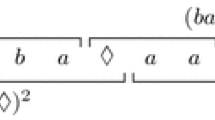Abstract
A word of the form WW for some word \(W\in \varSigma ^*\) is called a square, where \(\varSigma \) is an alphabet. A partial word is a word possibly containing holes (also called don’t cares). The hole is a special symbol  which matches (agrees with) any symbol from
which matches (agrees with) any symbol from  . A p-square is a partial word matching at least one square WW without holes. Two p-squares are called equivalent if they match the same set of squares. We denote by \( psquares (T)\) the number of non-equivalent p-squares which are factors of a partial word T. Let \(\mathrm {PSQUARES}_k(n)\) be the maximum value of \( psquares (T)\) over all partial words of length n with at most k holes. We show asymptotically tight bounds:
. A p-square is a partial word matching at least one square WW without holes. Two p-squares are called equivalent if they match the same set of squares. We denote by \( psquares (T)\) the number of non-equivalent p-squares which are factors of a partial word T. Let \(\mathrm {PSQUARES}_k(n)\) be the maximum value of \( psquares (T)\) over all partial words of length n with at most k holes. We show asymptotically tight bounds:
for some constants \(c_1,c_2>0\). We also present an algorithm that computes \( psquares (T)\) in \(\mathcal {O}(nk^3)\) time for a partial word T of length n with k holes. In particular, our algorithm runs in linear time for \(k=\mathcal {O}(1)\) and its time complexity near-matches the maximum number of non-equivalent p-square factors in a partial word.
P. Charalampopoulos—Supported by the Graduate Teaching Scholarship scheme of the Department of Informatics at King’s College London.
T. Kociumaka—Supported by Polish budget funds for science in 2013–2017 as a research project under the ’Diamond Grant’ program.
J. Radoszewski, W. Rytter and T. Waleń—Supported by the Polish National Science Center, grant no. 2014/13/B/ST6/00770.
Access this chapter
Tax calculation will be finalised at checkout
Purchases are for personal use only
Similar content being viewed by others
References
Bannai, H., I, T., Inenaga, S., Nakashima, Y., Takeda, M., Tsuruta, K.: A new characterization of maximal repetitions by Lyndon trees. In: Indyk, P. (ed.) 26th Annual ACM-SIAM Symposium on Discrete Algorithms, SODA 2015, pp. 562–571. SIAM (2015)
Blanchet-Sadri, F., Bodnar, M., Nikkel, J., Quigley, J.D., Zhang, X.: Squares and primitivity in partial words. Discrete Appl. Math. 185, 26–37 (2015)
Blanchet-Sadri, F., Jiao, Y., Machacek, J.M., Quigley, J., Zhang, X.: Squares in partial words. Theor. Comput. Sci. 530, 42–57 (2014)
Blanchet-Sadri, F., Mercaş, R.: A note on the number of squares in a partial word with one hole. Inform. Theor. Appl. 43(4), 767–774 (2009)
Blanchet-Sadri, F., Mercaş, R.: The three-squares lemma for partial words with one hole. Theor. Comput. Sci. 428, 1–9 (2012)
Blanchet-Sadri, F., Mercaş, R., Scott, G.: Counting distinct squares in partial words. Acta Cybern. 19(2), 465–477 (2009)
Blanchet-Sadri, F., Nikkel, J., Quigley, J.D., Zhang, X.: Computing primitively-rooted squares and runs in partial words. In: Kratochvíl, J., Miller, M., Froncek, D. (eds.) IWOCA 2014. LNCS, vol. 8986, pp. 86–97. Springer, Cham (2015). doi:10.1007/978-3-319-19315-1_8
Crochemore, M., Hancart, C., Lecroq, T.: Algorithms on Strings. Cambridge University Press, Cambridge (2007)
Crochemore, M., Iliopoulos, C.S., Kociumaka, T., Kubica, M., Langiu, A., Radoszewski, J., Rytter, W., Szreder, B., Waleń, T.: A note on the longest common compatible prefix problem for partial words. J. Discrete Algorithms 34, 49–53 (2015)
Crochemore, M., Iliopoulos, C.S., Kubica, M., Radoszewski, J., Rytter, W., Waleń, T.: Extracting powers and periods in a word from its runs structure. Theor. Comput. Sci. 521, 29–41 (2014)
Crochemore, M., Rytter, W.: Squares, cubes, and time-space efficient string searching. Algorithmica 13(5), 405–425 (1995)
Deza, A., Franek, F., Thierry, A.: How many double squares can a string contain? Discrete Appl. Math. 180, 52–69 (2015)
Diaconu, A., Manea, F., Tiseanu, C.: Combinatorial queries and updates on partial words. In: Kutyłowski, M., Charatonik, W., Gębala, M. (eds.) FCT 2009. LNCS, vol. 5699, pp. 96–108. Springer, Heidelberg (2009). doi:10.1007/978-3-642-03409-1_10
Fraenkel, A.S., Simpson, J.: How many squares can a string contain? J. Comb. Theory, Ser. A 82(1), 112–120 (1998)
Gusfield, D., Stoye, J.: Linear time algorithms for finding and representing all the tandem repeats in a string. J. Comput. Syst. Sci. 69(4), 525–546 (2004)
Halava, V., Harju, T., Kärki, T.: On the number of squares in partial words. RAIRO Theor. Inform. Appl. 44(1), 125–138 (2010)
Ilie, L.: A simple proof that a word of length \(n\) has at most \(2n\) distinct squares. J. Comb. Theory, Ser. A 112(1), 163–164 (2005)
Kociumaka, T.: Minimal suffix and rotation of a substring in optimal time. In: Grossi, R., Lewenstein, M. (eds.) Combinatorial Pattern Matching, CPM 2016. LIPIcs, vol. 54, pp. 28:1–28:12. Schloss Dagstuhl (2016)
Kolpakov, R.M., Kucherov, G.: Finding maximal repetitions in a word in linear time. In: 40th Annual Symposium on Foundations of Computer Science, FOCS 1999, pp. 596–604. IEEE Computer Society (1999)
Manea, F., Mercaş, R., Tiseanu, C.: An algorithmic toolbox for periodic partial words. Discrete Appl. Math. 179, 174–192 (2014)
Manea, F., Tiseanu, C.: Hard counting problems for partial words. In: Dediu, A.-H., Fernau, H., Martín-Vide, C. (eds.) LATA 2010. LNCS, vol. 6031, pp. 426–438. Springer, Heidelberg (2010). doi:10.1007/978-3-642-13089-2_36
Author information
Authors and Affiliations
Corresponding author
Editor information
Editors and Affiliations
Rights and permissions
Copyright information
© 2017 Springer International Publishing AG
About this paper
Cite this paper
Charalampopoulos, P. et al. (2017). Efficient Enumeration of Non-Equivalent Squares in Partial Words with Few Holes. In: Cao, Y., Chen, J. (eds) Computing and Combinatorics. COCOON 2017. Lecture Notes in Computer Science(), vol 10392. Springer, Cham. https://doi.org/10.1007/978-3-319-62389-4_9
Download citation
DOI: https://doi.org/10.1007/978-3-319-62389-4_9
Published:
Publisher Name: Springer, Cham
Print ISBN: 978-3-319-62388-7
Online ISBN: 978-3-319-62389-4
eBook Packages: Computer ScienceComputer Science (R0)




